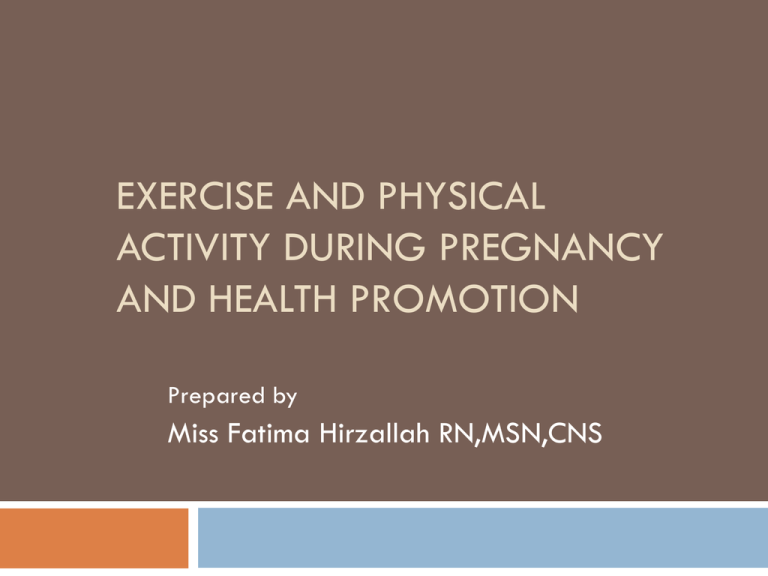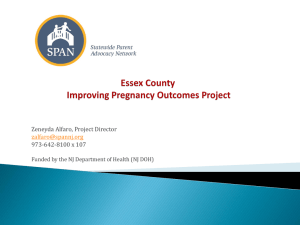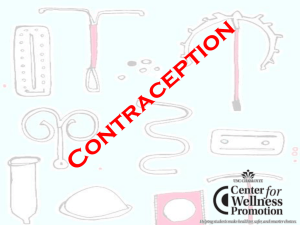Exercise during pregnancy and health promotion - An
advertisement

EXERCISE AND PHYSICAL ACTIVITY DURING PREGNANCY AND HEALTH PROMOTION Prepared by Miss Fatima Hirzallah RN,MSN,CNS Introduction Evidence shows that physical activity during and after pregnancy results in health gains for women Unless a pregnancy is determined to be highrisk (Cioffi et al 2010) Introduction It is important to evaluate a woman’s overall health before an exercise program is planned or recommended In the absence of any obvious contraindications, it is reasonable for pregnant women to continue (or even begin) moderate exercise (American College of Obstetricians and Gynecologists 2003) Introduction advise healthy women who are pregnant to engage in at least 2.5 hours of moderate intensity aerobic activity per week during pregnancy and after birth Examples of aerobic exercise are walking, swimming and dancing. (Cioffi et al 2010 ) How much exercise is advisable in pregnancy? Benefits of Exercise during pregnancy Physical activity is beneficial before, during and after pregnancy to : promote fitness and well-being minimize pregnancy discomfort prevent postpartum obesity (Kramer 2002) Benefits of Exercise during pregnancy During pregnancy, physical activity was considered to help with : weight management provide stress release reduce the chances of pregnancy - and/or birthrelated complications . Benefits of Exercise during pregnancy enable the bodily changes of pregnancy to be absorbed more easily increase energy levels. (Cioffi etal 2010 ) reduce the length of labour. prevent some cases of gestational diabetes, especially in morbidly obese women (BMI >33) (Artal 2003) Benefits of Exercise during pregnancy decrease risk of LGA, as might be expected given its useful effects on glucose tolerance (Alderman &Holt 1998) better posture helps prevent low back pain ,There is no evidence that it impairs birth outcomes(Kramer 2002) Types of exercise during pregnancy Upper Back and Abdominal Side Flexors stretching the rib cage and upper back strengthening the abdominal side flexors in preparation for postpartum recovery Abdominal side flexors Upper back and rib cage stretch Types of exercise during pregnancy pelvic tilt (Abdominal toners) are : excellent for toning and strengthening the abdominal muscles& rectus helpful in relieving lower back pain Pelvic tilt while on all fours. Types of exercise during pregnancy pelvic tilt helpful for decreasing the lumbar lordosis and realigning posture Pelvic tilt in the supine position. Types of exercise during pregnancy Tailor sitting position ( sitting with knees flexed) strengthens the thigh and stretches perineal muscles Squatting position : helps to stretch the perineal muscles (pelvic muscle ) Types of exercise during pregnancy pelvic floor( Kegel's muscle) The women tighten the perineum muscle. They form the essential to : support of the pelvic organs, and their tone and elasticity reduces the possibility of urinary incontinence with postpartum urination helps prevent prolapse of the uterus. Guidelines and Limitations Guidelines for a prenatal exercise program should take into consideration the woman's initial fitness level and the physiological changes taking place in her body . Guidelines and Limitations 1-The pregnancy condition produces an increase in body temperature; It's important to avoid overheating by not doing more than 20 minutes of fast exercise . 2-The resting heart rate of a pregnant woman naturally increases; avoid high intensity exercise ( Keep heart rate below 140 b pm). Guidelines and Limitations 3-The pregnant woman produces a hormone called relaxin ,The release of the hormone Relaxin makes all joints more mobile ; Avoid deep flexion or extension of the joints , Stay within the joints' range of motion . Guidelines and Limitations 4- The growing uterus begins to compress on the vena cava located deeply through the lower back/buttock area; Avoid exercises in the supine position (back lying) after the fourth month of gestation to avoid supine hypotension. Guidelines and Limitations 5-The amount of blood glucose can decrease much more rapidly in a pregnant state ;it is more important to have a sugar (eg., jelly, beans) at hand during exercise. 6-Drink plenty of fluids before, during and after exercise. 7-Finish with a gradual decrease of intensity, which includes static stretching. Guidelines and Limitations 8-Stop physical activity if any unusual symptoms appear and contact your doctor. 9-Avoid activities with a lot of rapid, repetitive jumping or jarring movements and sudden directional changes. Guidelines and Limitations 10-Limit vigorous exercise to 15 minutes. 11-avoid exercises that employ or produce the Valsalva maneuver(forcefully pushing while holding breath) (American College of Obstetricians and Gynecologists.(ACOG) 2003) Considerations Women should realize that not every form of exercise is safe during pregnancy particularly those exercises that involve balance, such as: skating skiing or bicycling, or contact sports like soccer or basketball. Once the fetus begins to grow larger and women begin to "show," balance is affected . Exercise Precautions If in pregnancy any of the following symptoms are experienced, exercise should cease immediately and the physician contacted: High heart rate Dizziness Headache Uterine Contractions Vaginal bleeding Exercise Precautions Amniotic fluid leakage Nausea Insufficient weight gain Shortness of breath Faintness Back or pelvis pain Decreased foetal movements Sudden swelling of ankles, hands and face. Contraindication Exercise during pregnancy ischaemic or valvular Heart disease Severe hypertension Risk of premature labour(incompetent cervix, multiple pregnancy, ruptured membranes) Growth retardation Pre-eclampsia Exercise during pregnancy Any illness or complication needs to be fully assessed by a physician before starting or continuing with an exercise routine . Exercise during pregnancy Antepartum care providers should: increase women's awareness of the benefits of activity in pregnancy provide reassurance about safety concerns present options to women that can guide their incorporation of recommended activity levels into their daily lives . THANKS References American College of Obstetricians and Gynecologists. Exercise during pregnancy and the postpartum period. Clin Obstet Gynecol 2003; 46: 496. Artal R. Exercise the alternative therapeutic intervention for gestational diabetes. Clin Obstet Gynecol ,2003; 46: 478. Beth W. Alderman MD, MPH, Hui Zhao MPH, Victoria L. Holt PHD.Maternal Physical Activity in Pregnancy and Infant Size for Gestational Age . Annals of Epidemiology1998, 8: 513519 References Jane Cioffi PhD, Virginia Schmied PhD, Hannah Dahlen PhD, Annie Mills PhD , , Charlene Thornton MScMed, Margaret Duff RM, PhD, Joanne Cummings PhD and Gregory S. Kolt .Physical Activity in Pregnancy: Women's Perceptions, Practices, and Influencing Factors , Journal of midwifery and women’s health 2010, 55:455-461 Kramer M S. Aerobic .excersise for women during pregnancy. Cochrane Database of Systematic Reviews, 2002. References Kelly R. Evenson and Chyrise B. Bradley .Beliefs about exercise and physical activity among pregnant women. Patient Education and Counseling2009, 79:124-129 Lanay M. Mudd, , Sarah Nechuta, James M. Pivarnik, Nigel Paneth and the Michigan Alliance for the National Children's . Study Factors associated with women's perceptions of physical activity safety during pregnancy . Preventive Medicine2009, 49:194-199 Marlos R. Domingues , Aluísio J. Barros and Alicia Matijasevich .Leisure time physic al activity during pregnancy and preterm birth inBrazil. international Journal of Gyneocology&Obstetrics2008,103: 9-15








